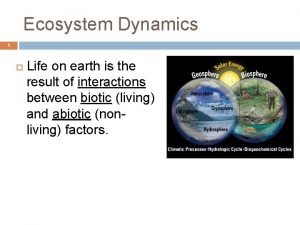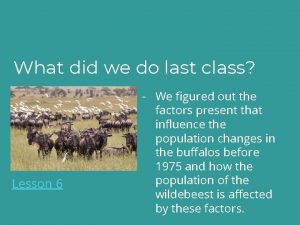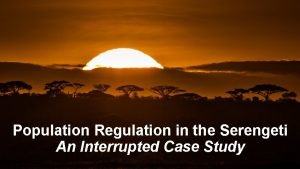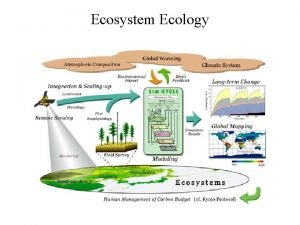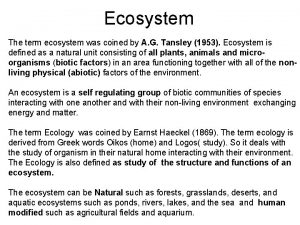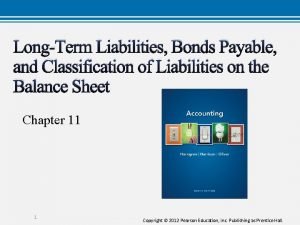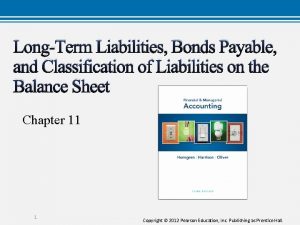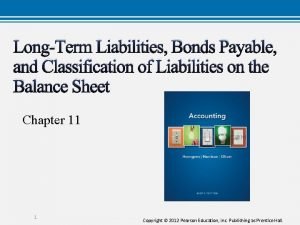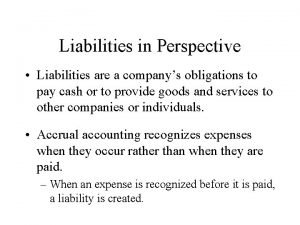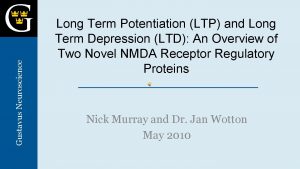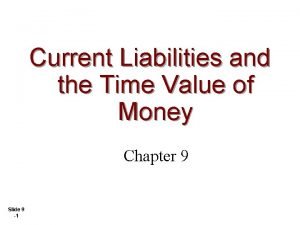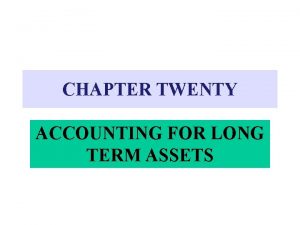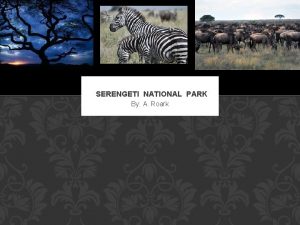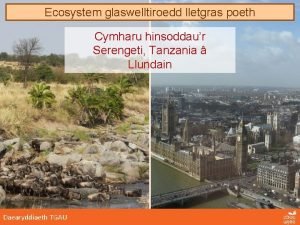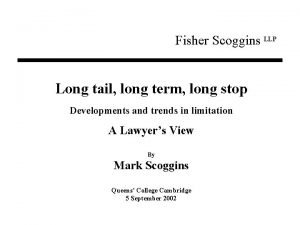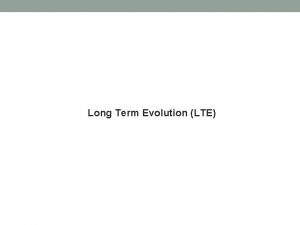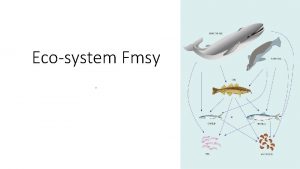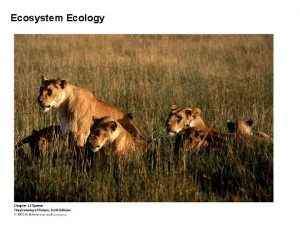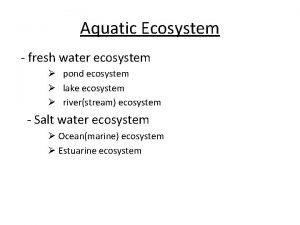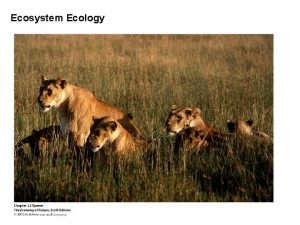Long term dynamics of the Serengeti Ecosystem SERENGETI


































































- Slides: 66

Long term dynamics of the Serengeti Ecosystem

SERENGETI ECOSYSTEM KENYA TANZANIA












Wildebeest migration patterns

The reason for dry season migration Kris Metzger



Migration patterns of Zebra and Gazelle

The Serengeti-Mara Ecosystem 24, 000 square kilometers Plains – woodland migration system 28 species of ungulates 10 species large carnivore, hyena most numerous

Population Size (x 1000) Serengeti Wildebeest Population 1800 1500 1200 900 600 300 0 1950 1960 1970 1980 1990 2000


The regulation of the wildebeest population • What caused the increase? • What caused the leveling out?



Population Size (x 1000) Serengeti Wildebeest Population 1800 Drought 1500 1200 900 Rinderpest removed 600 300 0 1950 1960 1970 1980 1990 2000



Serengeti Wildebeest per capita Dry Season Food 350 300 250 200 150 100 50 0 1960 1970 1980 1990 2000

Serengeti wildebeest regulation Food limitation allows regulation of the population so that it levels out at about 1. 3 million animals

Serengeti wildebeest competitors Food limitation leads to competition with some other grazing ungulates - Thomson’s gazelle But not Zebra – unknown why

Zebra and Thomson’s gazelle

Predation What is the role of predators in the ecosystem?


PREDATION AS A LIMITING FACTOR IN NON-MIGRATORY SERENGETI UNGULATES Tested by predator removal experiment: In northern Serengeti for 1980 -87 most large predators removed. Then they returned after 1987. Prey populations were compared to an adjacent non-removal area, Mara Park, Kenya

PREDATOR REMOVAL Oribi 18 kg Thomson’s gazelle 20 kg Impala 50 kg

Conclusions on regulation Large ungulate species food regulated Migrant species food regulated Small resident ungulate species predator regulated

Climate change - increase in wet season rain will increase fuel loads and burning - increase in dry season rain will increase fuel moisture and decrease burning So how does burning affect the system?

Consequences of extensive burning - The decline of savanna trees

Mara triangle 1944





Wildebeest grazing reduces grass fuel and area burnt

SERENGETI AREA BURNT IN DRY SEASON

Increase in wildebeest causes decrease in burning

Complex interactions of wildebeest and the environment The extent of grass fires is determined by the degree of grazing imposed by wildebeest

1980 1991 Savanna 1986 2003

Complex interactions –changes in tree populations Savanna trees have gone through a cycle of increase and decrease followed by increase again lasting about 100 years


Trees and elephant predation 1960 s – blamed for the decline of mature Acacia trees throughout savanna Africa. - Elephant culling




Trees and elephant predation 1970 s – fire rather than elephant shown to be the cause of decline (Norton-Griffiths work in 1970 s) Elephant play another role by feeding on seedlings




Trees and elephant predation 1960 s – the decline of mature Acacia trees throughout savanna Africa. Elephants are blamed. Elephant culling in Uganda, Kenya, Zimbabwe and South Africa. Not in Tanzania. 1970 s – evidence that excessive human caused fires reduce tree recruitment and tree populations collapse from senescence and not from elephant predation 1980 s – experimental evidence that elephants can prevent regeneration and maintain a grassland state


Serengeti elephant population Hunting 1880 s-1920 s Poaching Ivory ban


Serengeti keystones processes Hyena, Lion Small carnivores Wildebeest Resident ungulates Grasses Dicots Spatial heterogeneity

Conclusions Serengeti has shown • Evidence of natural regulation • Both bottom-up and top-down regulation occurs in the same system • There can be more than one state in species combinations • Keystone species can affect all levels in the system • There is long term natural change • Protected areas can provide baseline data to assess human impacts on other ecosystems

The End

Trees and elephant predation 1960 s – the decline of mature Acacia trees throughout savanna Africa. Elephants are blamed. Elephant culling in Uganda, Kenya, Zimbabwe and South Africa. Not in Tanzania.
 Long term plan and short term plan
Long term plan and short term plan Long term memory vs short term memory
Long term memory vs short term memory Long term hr planning
Long term hr planning Difference between long term and short term liabilities
Difference between long term and short term liabilities Long term liabilities
Long term liabilities Ling term goals
Ling term goals Long term and short term financial planning
Long term and short term financial planning Short short short long long long short short short
Short short short long long long short short short Once upon a time there was a little man
Once upon a time there was a little man Từ ngữ thể hiện lòng nhân hậu
Từ ngữ thể hiện lòng nhân hậu Climatograph definition
Climatograph definition Dynamics 365 ecosystem
Dynamics 365 ecosystem Serengeti.inquiry
Serengeti.inquiry Hhmi population regulation in the serengeti
Hhmi population regulation in the serengeti Nutrient cycle in the serengeti
Nutrient cycle in the serengeti The term ‘ecosystem’ was coined by *
The term ‘ecosystem’ was coined by * Term-to-term rule
Term-to-term rule Cubic sequence
Cubic sequence Term-to-term rule
Term-to-term rule Min term max term
Min term max term Term to term rule example
Term to term rule example Term to term rule
Term to term rule Institutional medicaid
Institutional medicaid Long term financing
Long term financing English 11 unit 10
English 11 unit 10 Long term scheduler
Long term scheduler Dts city pairs
Dts city pairs Short term disability manitoba
Short term disability manitoba Putting-out system
Putting-out system The long-term future of particle accelerators
The long-term future of particle accelerators Ww2 long term causes
Ww2 long term causes Long term causes of world war 1
Long term causes of world war 1 Nstu long term disability
Nstu long term disability Advantages of retained earnings
Advantages of retained earnings Long-term finance
Long-term finance Long term memory example
Long term memory example Physical fitness is the ability to
Physical fitness is the ability to Long-term incentive plan examples
Long-term incentive plan examples Prospective memory examples
Prospective memory examples Long term potentiation
Long term potentiation Long term storage and retrieval
Long term storage and retrieval What is long term notes payable
What is long term notes payable Notes payable journal entry
Notes payable journal entry What is long term notes payable
What is long term notes payable Orthogonal frequency division multiplexing
Orthogonal frequency division multiplexing Long term effects of anorexia
Long term effects of anorexia Are lipids long term energy storage
Are lipids long term energy storage Long term debt ratio
Long term debt ratio Effects of the industrial revolution
Effects of the industrial revolution Long term impacts of the industrial revolution
Long term impacts of the industrial revolution Long term potentiation
Long term potentiation Goals for teens
Goals for teens Desired goals meaning
Desired goals meaning Process of memory encoding
Process of memory encoding Franchise amortization
Franchise amortization Euro-btp
Euro-btp Current portion of long term debt
Current portion of long term debt Current portion of long term debt
Current portion of long term debt Long term storage and retrieval
Long term storage and retrieval Sum of the years method of depreciation
Sum of the years method of depreciation Long term debt instruments
Long term debt instruments Long term debt instruments
Long term debt instruments Pdp smart goals examples
Pdp smart goals examples Long term career goals examples
Long term career goals examples Other long term assets
Other long term assets Capacity of long term memory
Capacity of long term memory Long term debt in balance sheet
Long term debt in balance sheet










